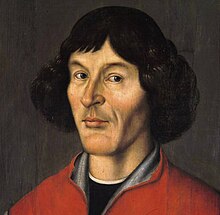Mikołaj Kopernik
| Nicolaus Copernicus | |
|---|---|

1580 portrait (artist unknown) in the Old Town City Hall, Toruń
|
|
| Born |
19 February 1473 Toruń (Thorn), Royal Prussia, Kingdom of Poland |
| Died | 24 May 1543 (aged 70) Frombork (Frauenburg), Prince-Bishopric of Warmia, Royal Prussia, Kingdom of Poland |
| Fields |
|
| Alma mater | |
| Known for |
Heliocentrism Copernicus' Law Copernican principle |
| Influences | Aristarchus of Samos, Martianus Capella |
| Signature | |
Nicolaus Copernicus (/koʊˈpɜːrnɪkəs, kə-/;Polish: Mikołaj Kopernik [miˈkɔwaj kɔˈpɛrɲik]; German: Nikolaus Kopernikus; 19 February 1473 – 24 May 1543) was a Renaissance mathematician and astronomer who formulated a model of the universe that placed the Sun rather than the Earth at the center of the universe, likely independently of Aristarchus of Samos, who had formulated such a model some eighteen centuries earlier.
The publication of Copernicus' model in his book De revolutionibus orbium coelestium (On the Revolutions of the Celestial Spheres), just before his death in 1543, was a major event in the history of science, triggering the Copernican Revolution and making an important contribution to the Scientific Revolution.
Copernicus was born and died in Royal Prussia, a region that had been part of the Kingdom of Poland since 1466. A polyglot and polymath, he obtained a doctorate in canon law and was also a mathematician, astronomer, physician, classics scholar, translator, governor, diplomat, and economist. In 1517 he derived a quantity theory of money – a key concept in economics – and in 1519 he formulated an economics principle that later came to be called Gresham's law.
...
Wikipedia
